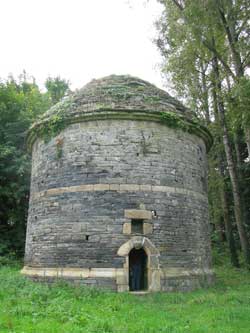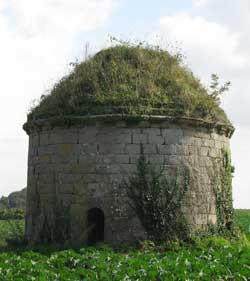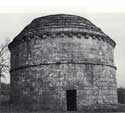
 |
 |
Dovecote of Keranroux |
|
The dovecote dates from the 16th century, but the current castle is of a later period built in 1773-1774 by the master of Fruglaye and his wife Caroline Caradeuc of Chalotais. It is beautifully designed and made of large blue schist stones, ornamented by two bands of pink granite. These are ornamentation only as they do not protrude beyond the wall to form a barrier against marauding predators, nor to provide a promenade ledge, which pigeons are so fond of. There is a very unusual niche above the door on the outside, which may have been used for some type of religious statue or other ornamentation. The door also is very ornate and the very apex has a carved stone that protrudes out and below the arch. But time has made the subject of the carving too obscure to even estimate a guess about what the original design represented. The granite band near the bottom of the cote is not simply flat stone, but is also ornamental with a smooth outward curve that makes the base of the cote larger than the rest. This gives it a sturdy elegant shape.
The dovecote is of just medium capacity, with 850 nest holes arranged in the common checkerboard pattern, with 25 rows of 34 holes each. Starting some distance from the bottom rows they are divided by landing boards every six rows as shown on the left.. The nest holes are "L" shaped, with each row's "L" shape alternating from right to left every other row. The nest holes are made of rather large pink granite stones of the same type as the ornamental bands on the outside. The landing ledges between the rows are made of the blue schist, but much thinner, providing more actual nest space per area. There is a rather large base which must have held a potence at one time, but nothing remains of it.
This is an absolutely beautiful must see dovecote. It can be found by leaving Morlaix going north on the D76, then turning right just before you go under the high freeway viaduct. The sewer plant will be on your left as you travel down this road for ½ Km to the gate marked Keranroux. There is a small space to park. The gate may be locked but there is a footpath, and pedestrian access is permitted. It is a very pleasant walk down a tree lined lane, and the dovecote will be found very near to the road on the right at about 300 meters from the gate. This is a lovely spot for your day's picnic, and with your empty bags you could haul back some trash, if any, left by less considerate visitors. We did.
 |
| Thumbnail image from Colombiers et Pigeonniers en Bretagne Profonde. |
Another dovecote very near is that of Pennele, Saint-Martin-Des-Champs. It lies just across the river from Keranroux, but we were not able to locate it from a public area, as it stands on private property. The manor to which it belongs is to the north of Morlaix on the D769, near the monastery Cordeliers de Saint-François. This monastery is famous in its own right, being where the first printing works of Brittany was established. Turn left just before St. Francis Retrait. Pennele is noted on a directional sign at the beginning of this local area road. The dovecote is reported to be located close to the confluence of the river Donant and Morlaix. This is a heavily wooded area, which may well have hidden the dovecote, and it might be visible during winter when the trees have lost their leaves.
It is also of blue schist construction, divided by two pink granite bands, similar to the dovecote of Keranroux, above. Reportedly, there are 25 rows of about 30 nest holes per row, making this a medium sized dovecote for the area, and slightly smaller than Keranroux. The dovecote is of the 16 or 17th century.
 |
Dovecote Kerouzere |
 |
 |
Tronjoly Dovecote |
|
Tronjoly dovecote dates from the 16th century, when Christopher de Kergoet, had it constructed.. The first documents pertaining to this old aristocratic Breton family date all the way back to 1296. The manorial unit passed to Parcevaux in 1738, and then in 1883 to the family of Penhoat, which resides at the manor to this day.
As seen in the picture, the dovecote is made of beautiful large granite blocks. The wall is capped with elegantly shaped granite stone corbelets that form the lower edge of the roof, and enhancing the dovecote's manorial presence. Somewhere in history though, it has lost its family armorial stone crest. The dovecote has approximately 600 nestholes laid out in 20 rows. They are of the standard arrangement, but the interior stones are also of rather larger size, separated horizontally with narrow schist plates . The potence stone is rather small, but the pivot hole is clearly visible. Unfortunately, the potence itself is no longer extant.
To find the dovecote, go north out of Cleder from the church toward Kerfissien. You will only travel about 1km along this road and there will be a sport stadium on the right. Tronjoly is sign posted on the left. Follow this dirt road about .6 km past a farm house to the manor gate. You can see the dovecote from the gate. It stands in an adjacent field and is clearly visible.
Other dovecotes in the area reported by Dr. Jean Auffret in Colombiers et Pigeonniers en Bretagne Profonde are noted below. We have provided small thumbnail images from the book to help you identify them. More detail on these dovecotes and larger images are in the book, which we highly recommend for any enthusiast. And of course, if you have any information on any of these or others you know of in the area that you would like to share, we would love to post it.
 |
Another dovecote we did not have time to try to find in the area west of Morlaix is that of
De Rosanbo, of Lanvellec. As with most of the family history of the dovecotes of Brittany, we are indebted to Dr. Jean Auffret’s book Colombiers et Pigeonniers en Bretagne Profonde. The property was owned by the former family of Coskaer since 1050, whose two members took part in the crusades. During the 17th century, the only heiress, Genevieve de Coskaer de Rozanbo, married Louis Peletier, first President at the Parliament of Paris.
The dovecote is made of large granite blocks. It appears to be similar in design to Tronjoly dovecote, although looks larger from this photograph The base, as is somewhat common for the area, is larger. It has an ornamental band called a rat course approximately helfway between the ground and the bottom of the roof, ostensibly to prevent rats from entering the dovecote, but also providing some ornamentation. The roof is supported by ornamental crenellations. For a dovecote with so much decorative detail, the door is rather plain, being a simple rectangular shape. It dates from 1697. A carved inscription can be found on the dovecote stating that "Louis Peletier, knight lord marquis de Rozanbo first President of the Parliament of Paris, made repair this dovecote in 1738". Thank you Louis.
 |
Dovecote LesmoalAnother dovecote we attempted to locate, but failed to find, is that of Lesmoàl of Plounerin. It is reported to be very well preserved. It is separated from the manor by the shaded road that goes from Plounérin to Guerlesquin. It is constructed of massive stones and capped with a cupola held up on five pillars. The top of the cupola is decorated with a finishing spindle. The base for the potence matches the massive construction of the rest of the dovecote, made of thick granite and over three feet in diameter. The roof is also supported with lovely crenulated corbelets.
|
 |
Dovecote GuernachanayAnother dovecote we did not have time to try to find in the area west of Morlaix is that of Guernachanay of Plouaret. It is of the circular behive type, but does have rather larger elegant corbelets supporting the base of the roof.
|
Area between Morlaix and Brest: ![]()
DAY |
||||||||||||||||||
| 00 | 01 | 02 | 03 | 04 | 05 | 06 | 07 | 09 | 10 | 11 | 12 | 13 | 14 | 15 | 16 | 17 | 18 | |